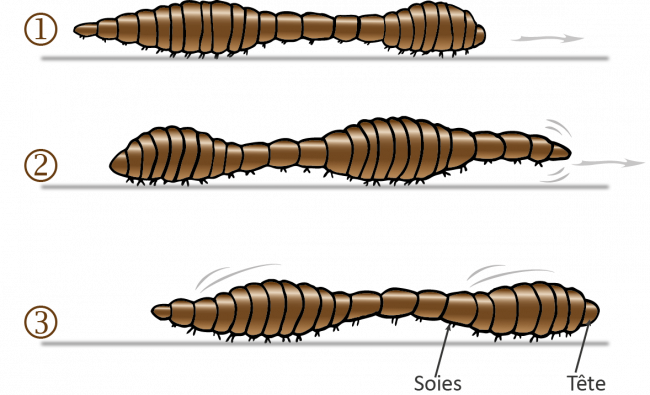Lifestyle of earthworms
Living in the ground is a funny idea! To be able to live in these conditions, earthworms have very specific adaptations.
Crawling and digging
The earthworm has circular and longitudinal muscles under its skin. If it contracts the circular muscles in the front part of its body, this area shrinks and extends forward. The worm anchors this area in the ground with its bristles. The worm crawls forward by alternating the lengthening and shortening of its body parts.
In order to sink into the soil, it pushes its thin "head" into a narrow crack, then contracts its longitudinal muscles, the front of its body thickens and spreads the soil. Earthworms can move up to 60 times their body weight in this way, making them - relative to their weight - among the most powerful animals in the world.
A fun experience!
In absolute silence, place an earthworm on a sheet of aluminium foil and listen carefully to the worm as it moves. You will hear a crunching sound as if the paper is being scraped by something hard. If you run your finger along the belly of the worm, from back to front, you will feel the presence of bristles that allow the worm to hold on and crawl forward. If you run your finger in the other direction, you will find it more difficult to feel them because they are inclined towards the back. It is possible to observe these bristles with a magnifying glass.
This experiment shows that the worm extends forward from the area of anchored bristles and then contracts the anchored front part while the rear part is detached.
Skin that breathes
Earthworms do not have lungs, oxygen passes through their very thin, permeable skin under which there are very fine blood vessels that will capture oxygen. The earthworm breathes through its skin.
Moisture is essential for earthworms to breathe: their skin will only be permeable if it is moist. When the weather is dry, some earthworms dig deeper galleries to stay moist. In summer, if you find dried out earthworms on the ground, they have died of suffocation.
Smell
Underground, some senses that seem indispensable to us are quite useless. Without ears and noses, earthworms are deaf and cannot detect odours. They also have no real eyes, but light-sensitive cells on the front and back of their bodies. These light-sensitive cells allow them to perceive changes in light.
Earthworms also have a sense of touch and gravity that helps them to orient themselves in their tunnel system. Finally, a sense of pressure enables them to feel vibrations and thus to flee in time when a predator approaches.
Cutting one earthworm does not make two!
We often imagine that if we cut a worm in two the two pieces will regenerate a new worm. This is not true!
In fact, only the front part containing the vital organs ("brain", stomach...) continues to live, provided that there are enough rings left behind the clitellum for the intestine to function properly. It is also important that the wound does not become infected.

